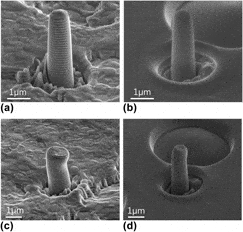Crossref Citations
This article has been cited by the following publications. This list is generated based on data provided by
Crossref.
Knorr, I.
Cordero, N.M.
Lilleodden, E.T.
and
Volkert, C.A.
2013.
Mechanical behavior of nanoscale Cu/PdSi multilayers.
Acta Materialia,
Vol. 61,
Issue. 13,
p.
4984.
Gram, Michael D.
Carpenter, John S.
Payzant, E. Andrew
Misra, Amit
and
Anderson, Peter M.
2013.
X-Ray Diffraction Studies of Forward and Reverse Plastic Flow in Nanoscale Layers During Thermal Cycling.
Materials Research Letters,
Vol. 1,
Issue. 4,
p.
233.
Zhang, J.Y.
Wang, Y.Q.
Wu, K.
Zhang, P.
Liu, G.
Zhang, G.J.
and
Sun, J.
2014.
Strain rate sensitivity of nanolayered Cu/X (X=Cr, Zr) micropillars: Effects of heterophase interface/twin boundary.
Materials Science and Engineering: A,
Vol. 612,
Issue. ,
p.
28.
Udompanit, Nattadon
Wangyao, Panyawat
Henpraserttae, Suparoek
and
Boonyongmaneerat, Yuttanant
2014.
Wear Response of Composition-Modulated Multilayer Ni-W Coatings.
Advanced Materials Research,
Vol. 1025-1026,
Issue. ,
p.
302.
Anderson, Peter M.
Carpenter, John S.
Gram, Michael D.
and
Li, Lin
2014.
Handbook of Nanomaterials Properties.
p.
495.
Lu, Y.Y.
Kotoka, R.
Ligda, J.P.
Cao, B.B.
Yarmolenko, S.N.
Schuster, B.E.
and
Wei, Q.
2014.
The microstructure and mechanical behavior of Mg/Ti multilayers as a function of individual layer thickness.
Acta Materialia,
Vol. 63,
Issue. ,
p.
216.
Raghavan, R.
Harzer, T.P.
Chawla, V.
Djaziri, S.
Phillipi, B.
Wehrs, J.
Wheeler, J.M.
Michler, J.
and
Dehm, G.
2015.
Comparing small scale plasticity of copper-chromium nanolayered and alloyed thin films at elevated temperatures.
Acta Materialia,
Vol. 93,
Issue. ,
p.
175.
Gram, Michael D.
Carpenter, John S.
and
Anderson, Peter M.
2015.
An indentation-based method to determine constituent strengths within nanolayered composites.
Acta Materialia,
Vol. 92,
Issue. ,
p.
255.
Lee, Subin
Jeong, Jiwon
Kim, Youbin
Han, Seung Min
Kiener, Daniel
and
Oh, Sang Ho
2016.
FIB-induced dislocations in Al submicron pillars: Annihilation by thermal annealing and effects on deformation behavior.
Acta Materialia,
Vol. 110,
Issue. ,
p.
283.
Yang, L. W.
Mayer, C.
Chawla, N.
Llorca, J.
and
Molina-Aldareguía, J. M.
2016.
Deformation mechanisms of ultra-thin Al layers in Al/SiC nanolaminates as a function of thickness and temperature.
Philosophical Magazine,
Vol. 96,
Issue. 32-34,
p.
3336.
Morusupalli, Rao
Rao, R.
Lee, Tae-Kyu
Shen, Yu-Lin
Kunz, M.
Tamura, N.
and
Budiman, A.S.
2016.
Critical Temperature Shift for Stress Induced Voiding in Advanced Cu Interconnects for 32 nm and Beyond.
Procedia Engineering,
Vol. 139,
Issue. ,
p.
32.
Zhu, Aibin
He, Dayong
He, Renjie
and
Zou, Chao
2016.
Nanoindentation simulation on single crystal copper by quasi-continuum method.
Materials Science and Engineering: A,
Vol. 674,
Issue. ,
p.
76.
Kim, Youbin
Baek, Jinwook
Kim, Sunghwan
Kim, Sangmin
Ryu, Seunghwa
Jeon, Seokwoo
and
Han, Seung Min
2016.
Radiation Resistant Vanadium-Graphene Nanolayered Composite.
Scientific Reports,
Vol. 6,
Issue. 1,
Specht, Paul E.
Weihs, Timothy P.
and
Thadhani, Naresh N.
2016.
Interfacial Effects on the Dispersion and Dissipation of Shock Waves in Ni/Al Multilayer Composites.
Journal of Dynamic Behavior of Materials,
Vol. 2,
Issue. 4,
p.
500.
Bie, B.X.
Huang, J.Y.
Su, B.
Lu, L.
Fan, D.
E, J.C.
Sun, T.
Fezzaa, K.
Qi, M.L.
and
Luo, S.N.
2016.
Dynamic tensile deformation and damage of B4C-reinforced Al composites: Time-resolved imaging with synchrotron x-rays.
Materials Science and Engineering: A,
Vol. 664,
Issue. ,
p.
86.
Ma, Fengcang
Wang, Tianran
Liu, Ping
Li, Wei
Liu, Xinkuan
Chen, Xiaohong
Pan, Deng
and
Lu, Weijie
2016.
Mechanical properties and strengthening effects of in situ (TiB+TiC)/Ti-1100 composite at elevated temperatures.
Materials Science and Engineering: A,
Vol. 654,
Issue. ,
p.
352.
Mara, Nathan A.
Li, Nan
Misra, Amit
and
Wang, Jian
2016.
Interface-Driven Plasticity in Metal–Ceramic Nanolayered Composites: Direct Validation of Multiscale Deformation Modeling via In Situ Indentation in TEM.
JOM,
Vol. 68,
Issue. 1,
p.
143.
Tian, Tian
Morusupalli, R.
Shin, H.
Son, H.-Y.
Byun, K.-Y.
Joo, Y.-C.
Caramto, R.
Smith, L.
Shen, Y-L.
Kunz, M.
Tamura, N.
and
Budiman, A.S.
2016.
On the Mechanical Stresses of Cu Through-Silicon Via (TSV) Samples Fabricated by SK Hynix vs. SEMATECH – Enabling Robust and Reliable 3-D Interconnect/Integrated Circuit (IC) Technology.
Procedia Engineering,
Vol. 139,
Issue. ,
p.
101.
Sahay, Rahul
Radchenko, Ihor
Budiman, Arief
and
Baji, Avinash
2017.
Measuring the Pull-Off Force of an Individual Fiber Using a Novel Picoindenter/Scanning Electron Microscope Technique.
Materials,
Vol. 10,
Issue. 9,
p.
1074.
Handara, V.A.
Radchenko, I.
Tippabhotla, S.K.
R.Narayanan, Karthic.
Illya, G.
Kunz, M.
Tamura, N.
and
Budiman, A.S.
2017.
Probing stress and fracture mechanism in encapsulated thin silicon solar cells by synchrotron X-ray microdiffraction.
Solar Energy Materials and Solar Cells,
Vol. 162,
Issue. ,
p.
30.



